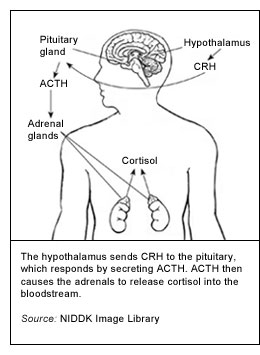Addison disease is also known as primary hypoadrenalism. It occurs when the adrenal glands stop producing sufficient amounts of the hormones cortisol and aldosterone. The adrenal glands are small organs that lie on top of the kidneys. The adrenal glands, together with the hypothalamus and pituitary glands in the brain, control many systems in the body. Disruption of this hormonal system can cause severe illness.
Addison disease is a rare condition affecting between 1 and 4 people per 100,000. It affects males and females of all ages. However, in general it affects women more commonly than men. Most of the adrenal gland (as much as 90%) is often destroyed before symptoms appear. When diagnosed it can be easily treated but without treatment the patient may die.

There are a number of causes of Addison disease:
In the Western world the most common cause (about 75%) is when the body starts to produce antibodies that attack the adrenal gland, an autoimmune disorder. Usually it is the outer part of the adrenal gland, the adrenal cortex that is affected. This means that the adrenal produces little or no steroid hormones like cortisol and aldosterone. Sometimes other hormone producing glands, most commonly the thyroid gland, are affected as well.
The next most common cause, and the most common cause worldwide, is infection. Infections include tuberculosis and some fungal infections, and failure of the adrenals may also occur in Acquired Immunodeficiency Syndrome (AIDS). Other causes are very rare and include tumours, bleeding (haemorrhage), bacterial, fungal and viral infections and surgery. A genetic cause is extremely rare.
Sometimes the adrenal gland produces little or no cortisol because the pituitary gland is diseased. The pituitary gland produces ACTH that stimulates the adrenal to produce cortisol. When the pituitary gland stops stimulating the adrenal gland to produce cortisol the condition is called secondary hypoadrenalism. In this situation the production of aldosterone by the adrenal is not affected.

